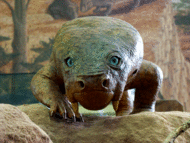Internal anatomy of therapsid skulls (Forerunners of Mammals)
The oldest mammals are known from the Late Triassic and evolved from a group of more primitive land-living vertebrates, the therapsids. Because therapsids were already particularly mammal-like, they are essential for the understanding of early mammalian evolution. Although numerous well preserved therapsid fossils from South Africa, Russia, China and South America exist, poorly is known about the internal anatomy of their skulls. We therefore plan to examine fossil skulls of these animals with neutron tomography and modern techniques of 3D modeling. Among others these examinations provide new insights into respiration, the functions of the brain and nervous system, senses (olfaction and hearing) and the feeding apparatus. A main goal of our project is to explore unknown sinus systems in the skull of anomodonts, which is a group of herbivorous therapsids. Air-filled sinuses in the skull are also known from extant mammals and humans, but are almost completely unknown from therapsids. PhD student: Michael Laaß
PIs: apl Prof. Dr. Eberhard “Dino” Frey SMNK, Prof. Dr. Wolfgang Stinnesbeck Excellency University Heidelberg
Selected Publications
- Laaß, M., Frey, E., Kaestner, A. (2013):
- The inner ear of Kawingasaurus (Synapsida, Anomodontia) – an adaptation to ground vibration detection?. In: Reitner, J., Qun, Y., Yongdong, W. and Reich, M. (Eds.): Palaeobiology and Geobiology of Fossil Lagerstätten through Earth History Abstract Volume, Göttingen, Universitätsdrucke: 93-94
- Laaß, M., Frey, E., Kaestner, A. and Vontobel, P. (2013):
- New insights into the sinus systems of nonmammalian synapsids with the help of neutron tomography.. Abstract 11th EAVP Meeting – Villers-sur-Mer France
- Laaß M., Frey E., Kaestner A., Vontobel P. (2012):
- New insights into hearing of early synapsids [Abstract]. Neutron Imaging User Symposium (NIUS) , Bad Zurzach, Switzerland
- Laaß, M., Frey, E., Hauschke, N., Wilde, V., Kaestner, A., Vontobel, P., Kardjilov, N. & Hilger, A. (2012):
- Neutron tomography and methods of 3D visualization for the non-destructive study of fossils. [Abstract]. International Conference on Fossil Digitizing and Digital Collection Data Handling , Berlin 24-26 Sept. 2012
- Laaß, M., Frey, E., Kaestner, A., Vontobel, P. & Hilger, A. (2012):
- Sound localisation in small anomodonts.. Terra Nostra 2012/3: 104
- Laass M., Frey E. (2011):
- An archosaur-like sinus system in the anomodont Diictodon. [Abstract]. European Association of Vertebrate Paleontologists, 9th annual Meeting, 14-19 June 2011 : 34-34
- Laaß, M., Hampe, O., Schudack, M., Hoff, C., Kardjilov, N. and Hilger, A. (2010):
- New insights into the respiration and metabolic physiology of Lystrosaurus.. Acta Zoologica 92(4): 363-371
- Laaß, M., Hampe, O., Schudack, M., Hoff, C., Kardjilov, N. & Hilger, A. (2009):
- Einsatz der Neutronentomographie bei der Erforschung der Evolution der säugetierähnlichen Reptilien (Therapsida). Abstract SNI 2010 "Deutsche Tagung für Forschung mit Synchrotronstrahlung, Neutronen und Ionenstrahlen an Großgeräten". , Berlin
- Laaß, M.; Hampe, O.; Schudack, M., Kardjilov, N. & Hilger, A. (2009):
- Why Lystrosaurus survived the Late Permian mass extinction.. Abstract 7th Annual Meeting of the European Association of Vertebrate Palaeontologists , Shaker Verlag: 40-40
- Laaß, M.; Hampe, O.; Schudack, M., Kardjilov, N. & Hilger, A. (2009):
- Neue Erkenntnisse zum Atmungssystem und Stoffwechsel von Lystrosaurus. In: Martin, T. and Kaiser, S.I. (eds.): Paläontologie - Schlüssel zur Evolution, 79. Jahrestagung der Paläontologischen Gesellschaft in Bonn, 5.-7. Oktober 2009, Kurzfassungen.. Terra Nostra 3







